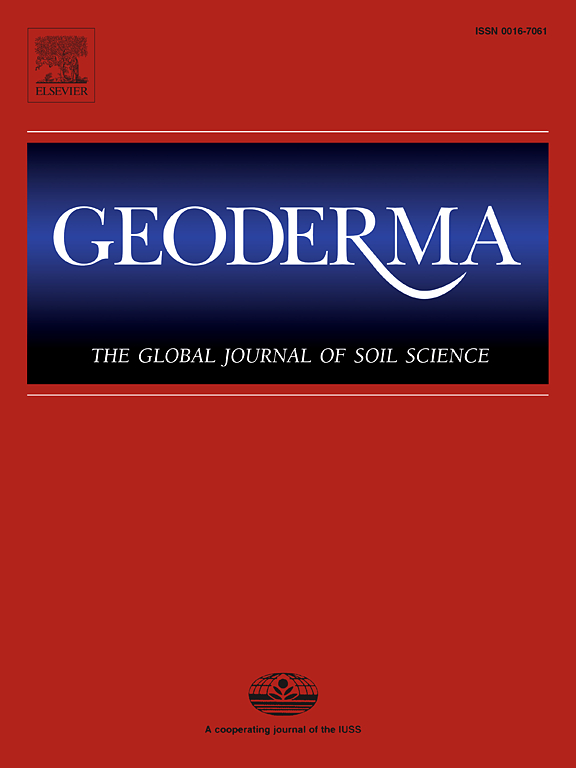Soil microbial C:N:P stoichiometry across environmental transects in China’s typical ecologically fragile regions
IF 6.6
1区 农林科学
Q1 SOIL SCIENCE
引用次数: 0
Abstract
The stoichiometry of soil microbial biomass is closely tied to the terrestrial cycling of carbon (C) and nutrients. Those stoichiometry influences not only soil fertility but also global change mitigation efforts. Ecologically fragile areas are commonly located in the ecotones between different ecosystems, with poor stability, weak ability to resist disturbance, and easy degradation. Yet the biogeographical patterns and potential mechanistic drivers of soil microbial biomass stoichiometry and its homeostasis in fragile ecosystems remain unclear. In this study we set three transects in typical ecologically fragile areas of China from which topsoil (0 − 20 cm depth) samples were collected to measure their microbial biomass carbon (MBC), nitrogen (MBN), and phosphorus (MBP). The results revealed much lower MBC (190.1 mg kg−1), MBN (20.5 mg kg−1), and MBP (7.1 mg kg−1) concentrations than their corresponding global and Chinese averages, but higher MBC:MBN (9.7), MBC:MBP (48.4), and MBN:MBP (4.3) ratios. The stoichiometric homeostasis (H, calculated by nonlinear fitting of microbial and soil stoichiometry) of MBC, MBN, and MBP concentrations ranged from 1.4 to 2.3, being weakly plastic to weakly homeostatic, while their ratios were generally homeostatic (with H ranged from 4.2 to 45.5). The MBC:MBN:MBP ratio was approximately 48:4:1. Overall, soil microbes were vulnerable to soil nitrogen and phosphorus limitations, compared to soil carbon. Soil MBC:MBN:MBP stoichiometry changed nonlinearly along the latitudinal gradient. Soil chemical and vegetation properties contributed the majority of variance explanations (> 62 %) to microbial biomass stoichiometry. Altogether, these findings provide new insight into the patterns and homeostasis of soil MBC:MBN:MBP stoichiometry in fragile ecosystems.
中国典型生态脆弱区环境样带土壤微生物C:N:P化学计量特征
土壤微生物生物量的化学计量与碳(C)和养分的陆地循环密切相关。这些化学计量不仅影响土壤肥力,也影响减缓全球变化的努力。生态脆弱区通常位于不同生态系统之间的过渡带,稳定性差,抗干扰能力弱,易退化。然而,脆弱生态系统中土壤微生物生物量化学计量及其动态平衡的生物地理格局和潜在机制驱动因素尚不清楚。本研究在中国典型生态脆弱区设置3个样带,采集表层土壤(0 ~ 20 cm)样品,测定其微生物生物量碳(MBC)、氮(MBN)和磷(MBP)。结果显示,MBC (190.1 mg kg - 1)、MBN (20.5 mg kg - 1)和MBP (7.1 mg kg - 1)浓度远低于相应的全球和中国平均水平,但MBC:MBN(9.7)、MBC:MBP(48.4)和MBN:MBP(4.3)的比值较高。MBC、MBN和MBP浓度的化学计量稳态(H,通过微生物和土壤化学计量非线性拟合计算)范围为1.4 ~ 2.3,为弱塑性到弱稳态,而它们的比值基本为稳态(H范围为4.2 ~ 45.5)。MBC:MBN:MBP比值约为48:4:1。总体而言,与土壤碳相比,土壤微生物更容易受到土壤氮和磷限制的影响。土壤MBC:MBN:MBP化学计量特征沿纬度梯度呈非线性变化。土壤化学和植被特性对变异解释贡献最大(>;62%)到微生物生物量化学计量学。这些研究结果对脆弱生态系统土壤MBC:MBN:MBP化学计量的格局和动态平衡提供了新的认识。
本文章由计算机程序翻译,如有差异,请以英文原文为准。
求助全文
约1分钟内获得全文
求助全文
来源期刊

Geoderma
农林科学-土壤科学
CiteScore
11.80
自引率
6.60%
发文量
597
审稿时长
58 days
期刊介绍:
Geoderma - the global journal of soil science - welcomes authors, readers and soil research from all parts of the world, encourages worldwide soil studies, and embraces all aspects of soil science and its associated pedagogy. The journal particularly welcomes interdisciplinary work focusing on dynamic soil processes and functions across space and time.
 求助内容:
求助内容: 应助结果提醒方式:
应助结果提醒方式:


